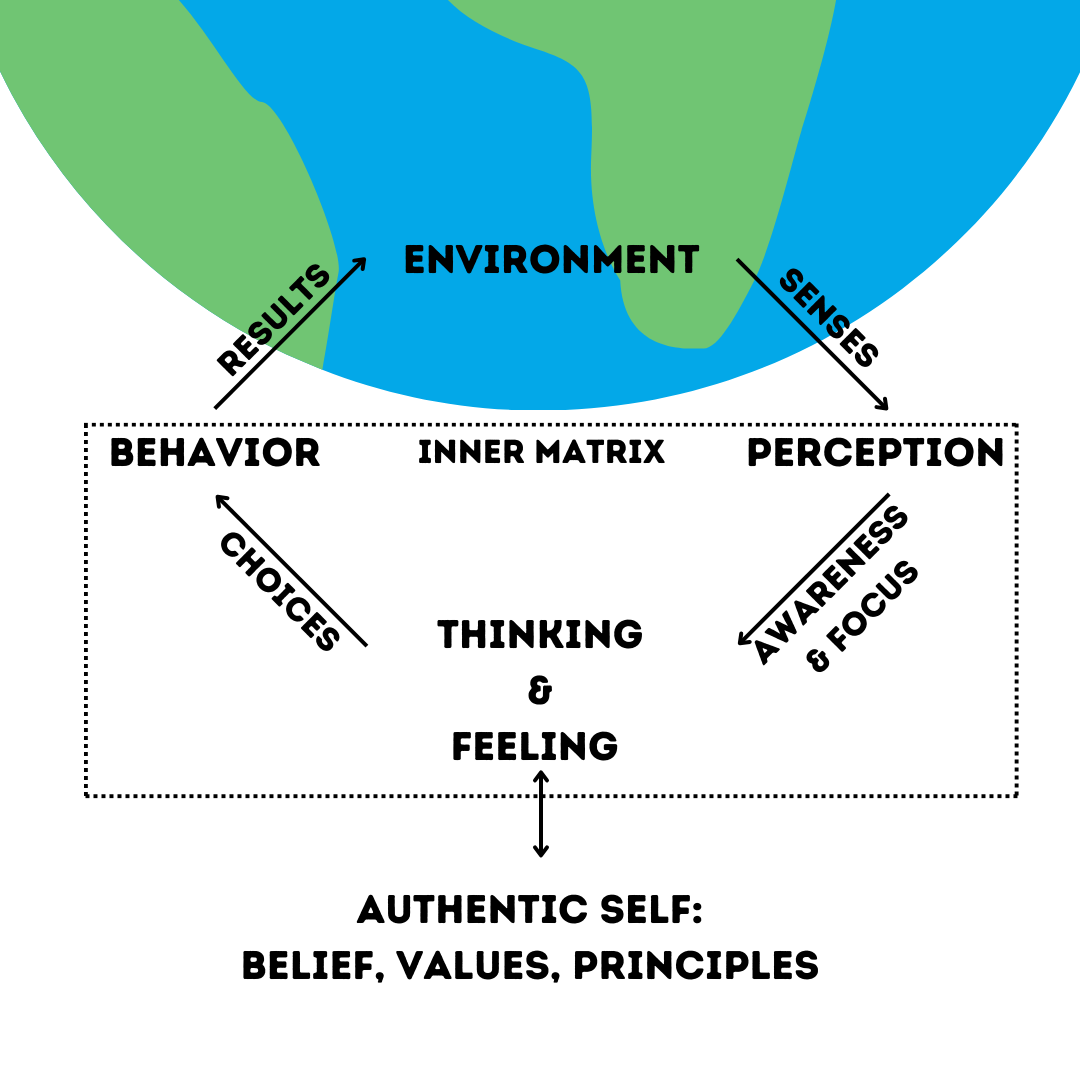Welcome to Part 3 of the “Wheel of Fate Series,” where we delve into the art of living by creating the life experience you desire, aligned with your authentic self.
The “Wheel of Fate” framework provides a practical explanation for what many refer to as Manifestation. In the series' final article, I'll discuss how to Cultivate your preferred life experience, going further than traditional manifestation techniques, to tie the series together.
If you haven’t already, I encourage you to read through the previous parts in the series:
Part 1: I Sought Control, and then Found Peace.
Part 2: The Power of Perception: The First of Four that Shape Reality.
This six-part series is interconnected, with links at the end of each article as they become available. Subscribe to receive updates.
In Part 1, we explored how our external world is shaped by our inner world—the Inner Matrix.
In Part 2, we saw how altering our perception can change our reality and how to shape our experience of reality.
Author's note: Anxiety and depression terms are used here to described emotional states of being, not clinically diagnosable conditions. It is important to note that in the context of this discussion, some individuals may experience anxiety and depression due to biochemistry imbalance. In such circumstances, anti-depressants and anxiolytics can proof helpful. The contributors to anxiety and depression are many. This read presents one perspective that aims to address its most common and most acute forms which arise out of unhealthy thinking patterns. The acute or chronic need for medication is a conversation that should be had with a psychiatrist you trust. For the rest of us, it might simply be a matter of doing some Inner Matrix housecleaning.
Today, we're thinking on “thinking”—a key part of our Inner Matrix.
Ever felt stuck because you thought too much about something? We'll explore how to balance planning effectively without overthinking.
We'll explore how to harness the mind's power by distinguishing between strategic thinking and over-thinking, and deciding when to act or be patient. We'll also build on what we discussed in Part 2: The Power of Perception, by discussing how to turn our perception inward to our thoughts and feelings without getting stuck in overwhelming feedback-loops.
As we are starting to see, each component in the Inner Matrix affects and relies on the other. This makes mastering it more of an art than a science. This read also introduces concepts that we unpack further in Part 4 which relates to our feelings. Here's a teaser: Imagine your feelings as the aim that guides you—how does your mind pull the trigger? This analogy will come to life as we delve deeper.
You'll learn to trust your decisions, become more mindful, and learn how to direct your thoughts and feelings more actively into productive behaviors:
Know the one task your mind is best-suited for.
Understand what happens when you use your mind for what it is not meant to.
How to manage over-thinking.
How anxiety is telling you to start with a sound decision.
How depression is telling you to make a different decision.
Have you ever considered how deeply your thinking affects your reality? Let's delve into how the mind's decision-making powers play a pivotal role.
The Mind as a Decision-Maker
The mind is first and foremost the decision-making tool of the Inner Matrix. Through this ability it provides structure to an otherwise unordered realm of the human experience.
Together with perception and feeling the mind can come to the table to help strategize what that decision will be. However, of the four components, it is the mind's job to make the final choice.
The word decision means, “to cut off.” That is in a nutshell what the mind is best used for. When our perceptions become too sensitive, the mind's job is to prune the extra fluff making it through perception's filter. When emotions cloud our judgment, it's the mind's task to clear away unhelpful thoughts from the ensuing emotional dis-regulation, ensuring clear decision-making.
Have you experienced moments where your mind successfully cut through emotional noise to make a clear decision?
The mind provides structure to our Inner Matrix. With our thoughts we train our perception and strategize the motivations of our heart.
The mind shoots the gun.
While this is what the mind excels at, it is capable of doing more. Using memories, perception, and emotion, we simulate the future and revisit the past. These simulations, aligned with our emotions, can guide us to better decisions—the heart aiming the gun.
But when we go from feeling emotion to becoming emotional, our biochemistry changes the very way the mind functions. This leads to over-thinking about the past or the future.
Now that we understand the mind's role in making decisions, how does this influence our perception of the future and our interpretation of the past?
The Double-Edged Sword of Future and Past
When the mind can't make a decision, it is common for it to slip into problem-solving.
Have you ever had someone come to you about a dilemma they're in and you move into problem-solving for them? Then, they get upset and say, “I just need you to listen to me!”
Turns out we do this to ourselves too. When we can't make a decision it is so easy for the mind to go looking for the solution. As I said in the previous section, it is capable of simulating possible solutions too, but more often than not it's the beginning of a vicious spiral.
Imagine a table with personified Mind, Perception, and Heart in conversation about a decision that needs to be made.
“Thank you all for coming,” says the Mind, “we have a problem we need to solve, but I can't find a solution. Now, I know my job here is to make decisions, but for the moment I'm going to come up with some scenarios and I need your help to choose the way forward.”
The mind's vision blurs as it outlines possible scenarios. In forecasting mode, Perception focuses on especially threatening possibilities, “That one grabs my attention!”
“Yeah,” the Heart skips, “That's a pretty terrifying one, Mind, we need to avoid that at all costs! Just think about all the terrible consequences that would come if THAT happened!”
This problem-solving session has become more of a problem-finding session. And all these problems don't have clarifying decisions behind them. The job of the mind becomes even more challenging, as it continues to think.
Perception then notices even more frightening scenarios.
The mind keeps thinking, slipping into over-thinking. The more it thinks, the more it forecasts doom, causing Perception to highlight the worst outcomes. This stirs up anxiety in our hearts. And with that anxiety greater urgency for the mind to find a solution.
It’s the mind’s job to keep us regulated and provide the structure of our Inner Matrix. With the mind unable to make a decision and distracted in simulations, it doesn’t check our perceptions and feelings and we become emotionally unregulated.
A similar challenge happens when we recreate failures and traumas of the past.
It might start with Perception noticing you're not making progress on your goals:
“Um, y'all, I hate to say this, but this isn't working,” says Perception.
“Ah man, not again, I hate feeling this way. I wish we felt motivated, but I just…sigh If we fail again, it's just going to be the end of us. Any ideas, Mind?”
Mind looks up, “Don't look at me! You know we've tried this before and it's no use. Better just accept this is how it's going to be for the rest of our lives in here.” And the mind repeats that message over and over and over again. Once again overthinking, but this time focused on the past. Perception pulls in more evidence that it is going to last forever, and the Heart feeling more and more depressed.
This is how depression spirals around in the Inner Matrix. Still, the mind is not performing its most important job—decision-making. But with depression, rather than becoming over-active looking for scenarios, it becomes under-active leading to a condition of “learned helplessness.”
Learned helplessness is the self-defeating box depression puts us in when we tell ourselves there's no use of trying anymore.
Advice often tells us to stop thinking about anxious or depressive thoughts or to distract ourselves. But that's easier said than done. Our perception is alert to the issue, our emotions are involved, and stopping our thoughts requires significant effort.
Recognizing the spiral of over-thinking can be daunting, but what practical steps can we take to navigate away from this cycle?
Strategies for Managing Over-Thinking
If we ask ourselves why over-thinking is happening in the first place we might get a few perspectives:
Trying to find a solution (anxiety)
Stuck in defeating self-talk (depression)
Paying heed to possibilities with inflated significance
A strong desire to resolve the inner conflict
At the risk of over-thinking, I'm sure we could come up with more.
The suggestion here is simple: over-thinking leads to mental function that distracts it from its main job.
Decision-making.
In both of the examples in the previous section it was the brain's inability or unwillingness to come to a decision that led to problems.
What's a mind to do if it can't make up its own mind?!?
Rather than slipping into forecasting and starting a solution-finding session that quickly turns into a problem-finding one, let's practice taking a beat.
Just like that friend who tells you they have a dilemma, you may not need a solution as much as you just need someone to calm you down and help widen your perspective.
Over-thinking often happens when we're stuck and can't decide what to do next. It's like the mind is a car spinning its wheels in the mud. The key to getting unstuck isn't to keep spinning — it's to find solid ground. This means making a simple but powerful decision: to stop the cycle and focus on what we can control. It's about telling the mind, 'Let's pause, take a step back, and look at our options clearly.' This decision helps us regain our mental balance and move forward.
You need a mind that says to Perception, “Hey, chill a bit. Where's the fire? I know it's your job to find threats, but can you set your preferences to focusing on the opportunities here for a bit?”
You need a mind that says to Heart, “Hey, slow down. I understand how you're feeling right now and I can understand why you want me to make a decision, but there's a few things we need to consider. I need your help to keep the calm so I can think clearly, and so Perception can focus on the right stuff.”
This is mindfulness at its core. If over-thinking is a result of not wanting or being able to come to a decision, getting the mind back on track to keep the structure of your Inner Matrix together is the decision it should make.
I have many reads on mindfulness practices for you to deepen your experience. Here's one to get you started:
Be sure to subscribe for more mindfulness reads as they become available.
Choosing to stay calm and emotionally balanced is like opening the windows to let fresh air into a stuffy room. Suddenly, we can see things from a new angle, think more creatively, and come up with fresh ideas. It's a team effort, though. Our thoughts, feelings, and perceptions need to join forces. When they work in sync, we can get through life's challenges with some truly inspired thinking.
With these strategies in hand, how can we shift our perspective on anxiety and depression as signals, rather than states of being, within our Inner Matrix?
Understanding Anxiety and Depression: A New Paradigm
Perhaps this article is giving you a nuanced perspective on anxiety and depression. Let's put a finer point on it.
If we can get on board with the idea that both anxiety and depression are the result of the mind not doing its jobs well and in order:
Make the decision
Hold structure and regulate the Inner Matrix (create order out of chaos)
Forecast creative solutions
then, solving the form of overthinking that comes with anxiety and depression is going back to the top of the job list and working our way back down. This would resolve most anxiety and depression today as the skill to do so is practiced.
But more than that, what anxiety and depression are is not a signal to figure it out already, but a signal to reconnect with the state of your Inner Matrix through a mindfulness practice and regain your ability to consciously direct it again.
If there's a way to “cure” these feelings, it's not by defining ourselves by them—instead of saying “I'm anxious” or “I'm depressed,” understand these feelings as signals: “I'm feeling anxious,” and “I'm feeling depressed.” This subtle shift encourages a different way to approach them mentally. They're clues from our Inner Matrix that it's time to find emotional balance again.
The mind, above all, is the component of the Inner Matrix that creates order out of chaos.
Author's note: I kindly remind the reader of the note at the beginning of this article for important clarification of the terms, anxiety, and depression.
How does this new understanding of anxiety and depression affect the dynamic interplay between our perception, thinking, and feeling?
The Interplay of Perception, Thinking, and Feeling
Learning to use the mind to provide the structure the Inner Matrix needs to function optimally is the most important take away from this read.
Without its guiding structure, too much thinking can make us too sensitive and emotional, throwing our feelings into chaos. When this happens, the mind struggles to find stability.
Perception is a self-reflexive process, as we talk about in Part 2: The Power of Perception: The First of Four that Shape Reality. This makes the mind's job crucial. Without the mind's order, our thoughts and feelings can become jumbled. This confusion can actually change our brain over time, making our view of ourselves and the world skewed and less accurate.
When the mind brings order, we can feel emotions without being overwhelmed by them. We're also better at judging what's important right now and what's not.
This creates a balance among how we perceive, think, and feel, sharpening our understanding instead of letting biases take over.
Better thinking leads to better feeling. Better feeling leads to better thinking.
Better thinking and feeling leads to improved perception. Improved perception leads to better thinking and feeling.
This is neuroplasticity and the self-reflexive property at work.
When our perception, thoughts, and feelings are in sync, our actions follow suit, all guided by the mind—the conductor of our Inner Matrix.
In this installment, we've uncovered that the mind is perfectly designed to "pull the trigger" on decisions. But what guides these shots? That's where our next journey begins, diving into the “aiming” mechanism of our Inner Matrix: our Feelings.
Mastering the trigger is only half the battle. Aligning our aim is crucial for hitting the mark. Have you ever leaped into a decision that missed its target? Reflect on those moments when your aim might have been off. Stay tuned as we explore how to fine-tune our emotional sights for better, more informed decisions.
Future Articles in the Series
Look out for these future articles in the series. Be sure to subscribe so you are notified when their posted!
Feeling: Understanding how feelings shape thoughts and hint at deeper values and beliefs.
Behavior: How changing our actions can transform our environment and ourselves.
The Wheel of Fate: Embracing destiny through Authenticity.
Return to Previous Article in the Series
Environment: Shifting from Controlling the Environment to Mastering the Inner Matrix.
Perception: How altering our perception can change our reality.









